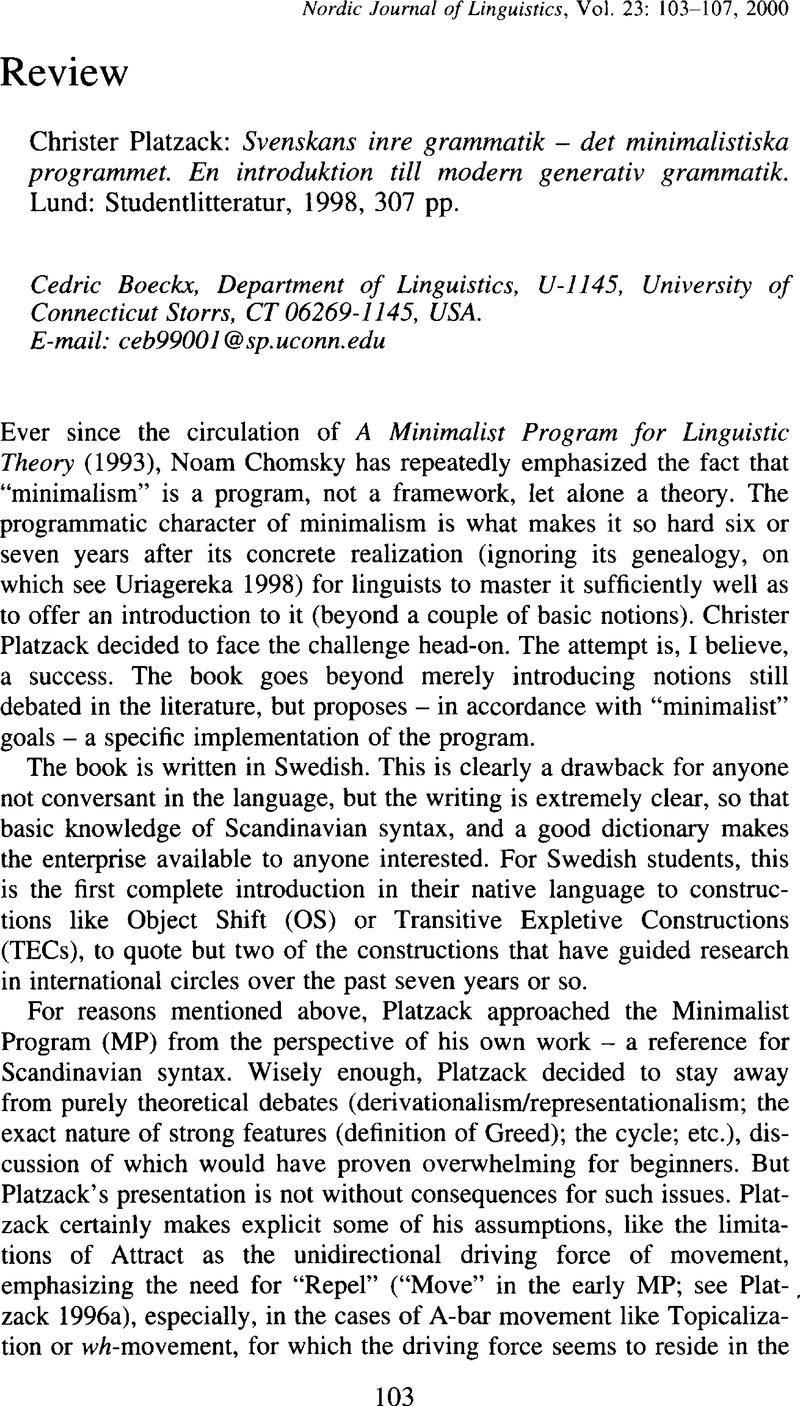No CrossRef data available.
Article contents
Christer Platzack: Svenskans inre grammatik – det minimalistiska programmet. En introduktion till modern generativ grammatik. Lund: Studentlitteratur, 1998, 307 pp.
Review products
Christer Platzack: Svenskans inre grammatik – det minimalistiska programmet. En introduktion till modern generativ grammatik. Lund: Studentlitteratur, 1998, 307 pp.
Published online by Cambridge University Press: 22 December 2008
Abstract
An abstract is not available for this content so a preview has been provided. Please use the Get access link above for information on how to access this content.

- Type
- Reviews
- Information
- Copyright
- Copyright © Cambridge University Press 2000
References
REFERENCES
Bošlcović, Ž. 1997. Non-finite Complementation: An Economy Approach. Cambridge, MA: MIT Press.Google Scholar
Branigan, P. 1996. Verb-second and the A-bar Status of Subjects. Studia Linguistica 50, 50–79.CrossRefGoogle Scholar
Chomsky, N. 1993. A Minimalist Program for Linguistic Theory. In Hale, K. & Keyser, S. J. (eds), The View from Building 20. Cambridge, MA: MIT Press, 1–52.Google Scholar
Chomsky, N. 1994. Bare Phrase Structure. MIT Occasional Working Papers in Linguistics #5, Cambridge, MA: MITWPL. Published in Webelhuth G. (ed.), Government and Binding Theory and the Minimalist Program. Oxford: Blackwell, 383–439.Google Scholar
Chomsky, N., & Lasnik, H. 1993. The Theory of Principles and Parameters. In Jacobs, J., von Stechow, A., Sternefeld, W. & Vennemann, T. (eds), Syntax: A Handbook of Contemporary Research. Berlin: de Gruyter, 506–569.CrossRefGoogle Scholar
Cinque, G. 1999. Adverbs and Functional Heads: A Cross-linguistic Perspective. Oxford: Oxford University Press.CrossRefGoogle Scholar
Holmberg, A., & Platzack, C. 1995. The Role of Inflection in Scandinavian Syntax. Oxford: Oxford University Press.CrossRefGoogle Scholar
Lasnik, H. 1999. On Feature Strength: Three Minimalist Approaches to Overt Movement. Linguistic Inquiry 30, 197–217.CrossRefGoogle Scholar
Martin, R. 1996. A Minimalist Theory of PRO and Control. Ph.D. Thesis, University of Connecticut.Google Scholar
Platzack, C. 1996a. Germanic Verb Second Languages. Attract vs. Repel: On Optionality, A-bar Movement, and the Symmetrical/Asymmetrical Verb Second Hypothesis. In Lang, E. & Zifonun, G. (eds), Deutsch – typologisch. Berlin: de Gruyter, 92–120.CrossRefGoogle Scholar
Platzack, C. 1996b. The Initial Hypothesis of Syntax: A Minimalist Perspective on Language Acquisition and Attrition. In Clashen, H. (ed.), Generative Perspectives on Language Acquisition. Amsterdam: John Benjamins, 369–414.CrossRefGoogle Scholar
Platzack, C. 1998. A Visibility Condition for the C-domain. Working Papers in Scandinavian Syntax 61, 53–99.Google Scholar
Rizzi, L. 1997. The Fine Structure of the Left Periphery. In Haegeman, L. (ed.), Elements of Grammar. Dordrecht: Kluwer, 281–337.CrossRefGoogle Scholar
Zwart, C. J.- W. 1997. Morphosyntax and Verb Movement: A Minimalist Approach to the Syntax of Dutch. Dordrecht: Kluwer.CrossRefGoogle Scholar


